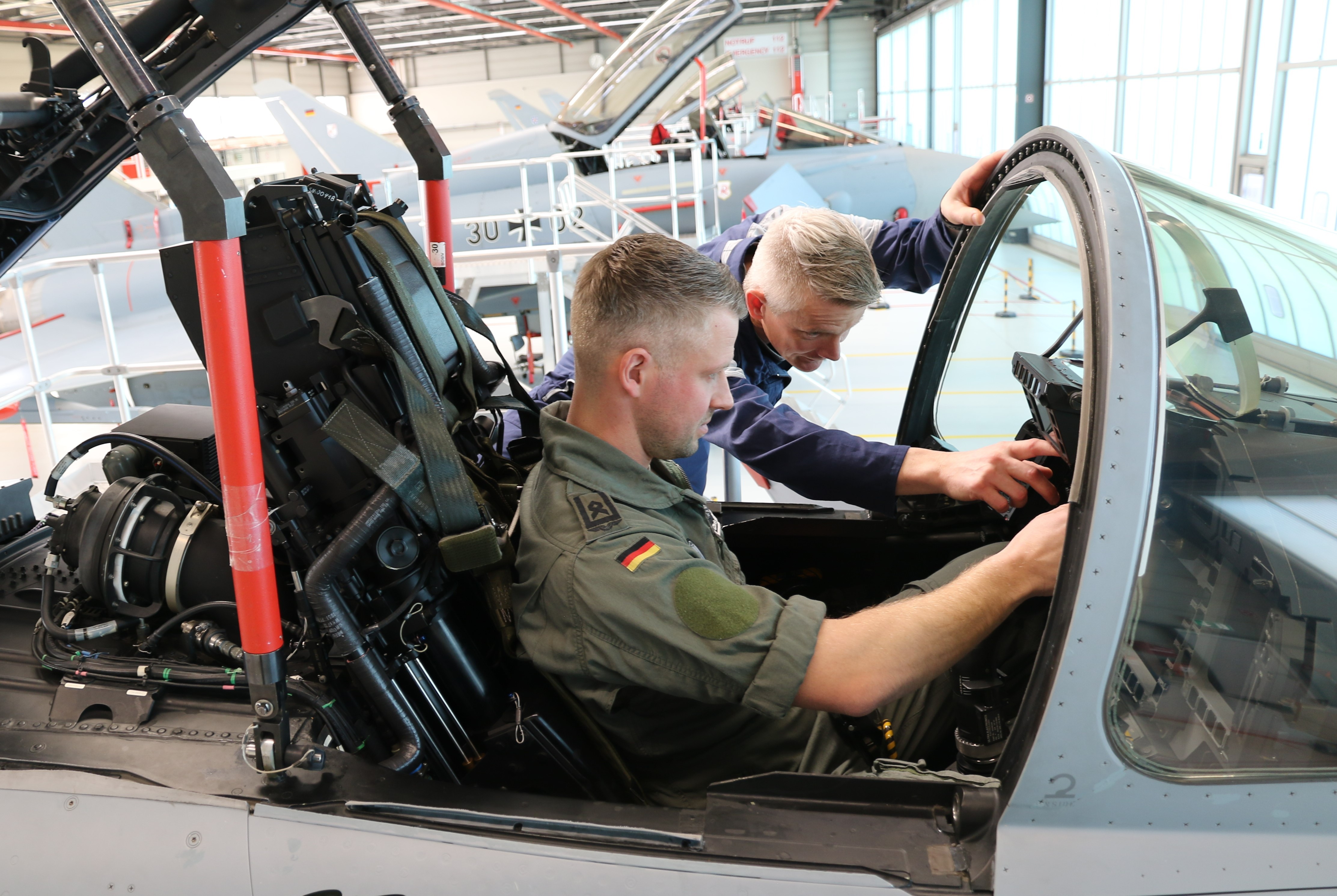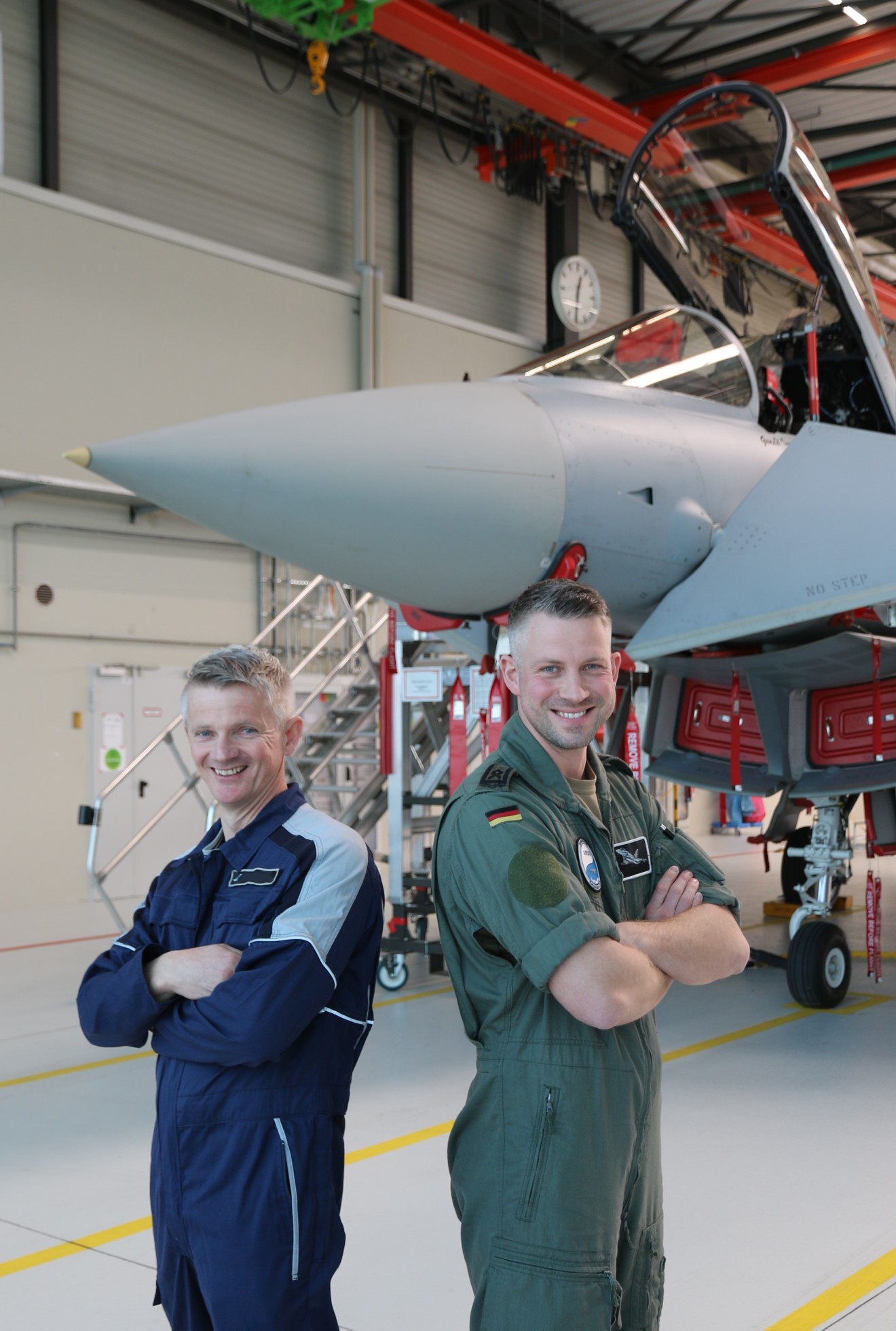Not many people can say their career has spanned a nation’s entire combat aircraft production run. Christian Dotzauer can. When it comes to Eurofighter production, Christian has been there, seen it and worn the blue overalls.
After joining the German Air Force (GAF) in 1993, he went on to serve for 12 years, predominantly working as Crew Chief on the F-4F Phantom in the GAF squadron TaktLwG 74 in Neuburg in South Germany. Highlights included training missions overseas, which took Christian to Sardinia, Portugal, the United States and Canada — before taking up a new challenge in industry.
“The end of my service in 2003 coincided with the start of the Eurofighter programme in Manching,” he says. “It was a one-time chance to be part of a Serial Instruction Pilot Training project — essentially, the pilot and technician training involving both the industry and the German Air Force. I was lucky.”
Christian joined the industry team just before the world’s first series production Eurofighter jet took off on its maiden flight from Manching on 13 February 2003. The aircraft GT001 (GT stands for German Trainer) was delivered to the German Air Force School of Engineering No.1 in Kaufbeuren, where it was used to train ground personnel.
“I am proud that I can say that I have been here for the entire series production,” he says. “I’ve also been here for the delivery of every aircraft to our neighbour Austria. Honestly, it is an honour for me to work on this programme.
“Of course, when you have been around the programme so long you become the ‘go-to’ person. When new people join the team, they tend to come to me when they have questions. But when I started it was really all new territory for me. I had to make a transition from the air force to civilian life, and from F-4F Phantom to Eurofighter, so I really had to rely on my new Airbus colleagues. They were very familiar with the Eurofighter prototypes and trained me on the new weapon system. Even back then there was very close cooperation between the industry team and the Air Force and the working relationship was very good.”
We Learn From Each Other
That partnership — solidified with the founding of the EKZ — continues today. And it’s as important as ever. German Air Force Master Sergeant Chris Limpächer, an Avionic-Tester, is part of the unit in Manching. He says: “There are real synergies between the Air Force and Airbus. We learn from each other. As soldiers we learn from the industry and get to see from them how the aircraft is built. Of course, it works the other way around too. Our industry colleagues learn from the people who fly the aircraft and who can flag up new issues, because they have an operational understanding of what's required.”
"This pooling and exchange of knowledge is what makes the EKZ such an effective collaborative effort. Says Chris: “In my team — the Tester team — there are three soldiers from the Air Force and around 30 Airbus people. In other areas of the centre the numbers are different but whatever the function, we all work side by side.”
Chris actually started his working life training to be a car mechanic but decided to join the army because he felt it would be a better long-term career. After joining the Bundeswehr as an apprentice aircraft mechanic in Rostock/Laage (North Germany) in the GAF squadron TaktLwG 73 , his four-year apprenticeship took him all over Germany. Then, within a few weeks of completing it, he was deployed to Sardinia. He says: “It was the first time I worked on the Eurofighter, and it was very exciting. It was an interesting experience not least because I was working alongside Italians, seeing a different culture, and a completely different way of working. I really enjoyed the corporation between the different countries.”
On his return to Laage, Chris was encouraged to develop his knowledge further and he became a leader of the High Frequency Technology team. Then after learning about the EKZ from other colleagues, he volunteered to be transferred. In Manching, Chris was testing all the aircraft’s different systems, which meant expanding his understanding further.
“What I find interesting about the corporation is that you get to learn how the aircraft’s systems are connected and interlinked,” he says. “You’re not solely focused on one system, which you can be in the Air Force. Instead, you get the whole overview. Working here also creates shared connections and experiences between people. So even when Air Force colleagues move on to bases, they can still tap into the knowledge of the teams here.
“That’s where the co-operation with industry has been valuable. I really like the environment here. Working alongside industry, is different to the way things work in the Bundeswehr. But obviously I am still in the army and must fulfil those duties too. It’s like having two jobs!”
Christian says understanding the Air Force perspective also helps his crew chief role: “Having the background knowledge is very useful because when a pilot is describing a problem you need to have a good all-round understanding of the aircraft. The good thing is that here you have people around you who understand the whole aircraft.
“Of course, I’ve worked in the aerospace industry for 30 years and experienced many highs and lows, but we have a simple mantra — never give up. We know that, together as a team, we will be able to solve the challenges and problems that come our way.”

A Team with A Mission
There’s a real sense of pride and purpose among members of the EKZ.
As crew chief, Christian’s job comes with real responsibility. His is the last signature on the paperwork (the Flight Service Certificate) before the pilot gets into the cockpit.
“You must take the job seriously,” he says. “The German Air Force is tasked with securing the borders of NATO countries. That is only possible if the pilots are well trained, if the aircraft is working well and if it is maintained the way it should be. Obviously, we are a part of the big picture but if we don't work together, don't maintain the aircraft and if it’s not ready to fly, then the borders can’t be secured.”
Chris agrees that it’s a job with significant responsibilities. “Every job is important, but the Eurofighter programme is a special one. There's a serious side to what the Eurofighter represents. Everyone working on the aircraft has to act responsibly because the pilots operate in very difficult and often dangerous situations.”
Today the Eurofighter programme is entering a new phase, following the Quadriga contract which will see 38 new Eurofighter jets built for the German Air Force. They will be the most up to date European combat aircraft ever with a service life well beyond 2060.
It means Christian, Chris and the rest of the EKZ will be busy for many years to come!
A Typical (Flight Operation) Day for a Crew Chief through the eyes of Christian Dotzauer
Flight safety is paramount in everything we do. Test work starts on the day before the flight with the registration of the aircraft on the day itself, work starts at 6am. We carry out a series of pre-flight checks. This means checking the aircraft from the outside and inside the cockpit including the ejection seat. Once everything is checked, I sign the documents and report the aircraft ready for flight at the Flight Operations Centre.
Then the main pre-flight briefing takes place. This includes members of the ground crew, the pilot and the flight test engineer. Here, we discuss any problems the aircraft may have had previously and the work we’ve done to solve them. The pilot discusses the test points he has to carry out during the flight. Then I sign the paperwork that states the aircraft is fit to fly and hand it to the pilot. At that point the responsibility for the aircraft transfers to the pilot.
Before the pilot enters the cockpit, he does a final walk around. During this “See Off” inspection, a number of checks are carried out with running engines. If everything is okay, the pilot taxis to the “Last Chance Check”, which is carried out by the crew chief before the Eurofighter takes off for its test flight. Typically, the flight time is 50 to 70 minutes and during that time my team and I are on standby in the hangar. Then, on the aircraft’s return, there’s another ‘see in’ inspection, before the debriefing when the pilot talks through how the flight went.
